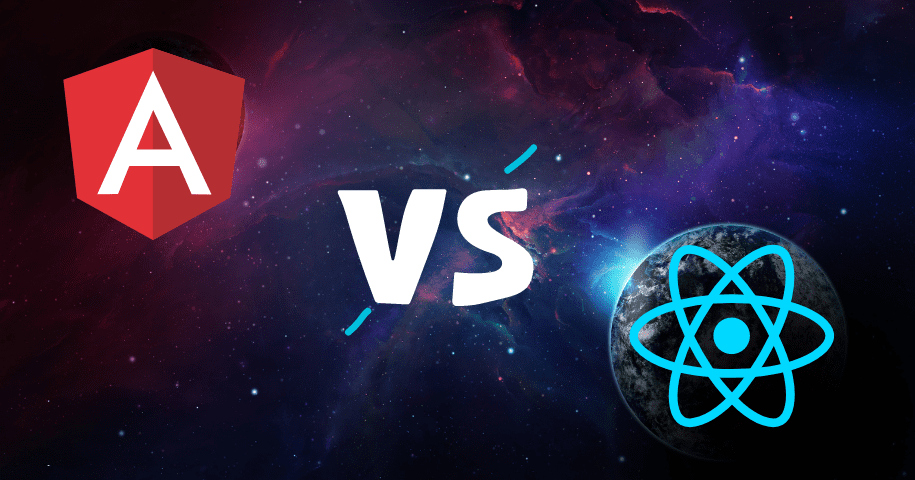Angular and React are the most well-known JavaScript frameworks and tools among programmers. Both are of utmost importance to them, but most people are confused about choosing between Angular Vs React for web app development.
As a result, we think it is appropriate to point out the significant differences between Angular and React to help you decide which is ideal for your upcoming or ongoing web development project.
React vs Angular seems to be a lengthy discussion despite the wide variety of frameworks available, yet both are more popular and developing faster than the competitors.
Along with the differences in both these frameworks, you will see which kind of project will require Angular and which project should be developed in React. Let’s dive in to learn more about Angular vs React.
What is React?
A JavaScript open-source library for the front formation is called React. It is applied to the creation of UI components or user interfaces. Developers may quickly construct interactive and complex UIs because of their component-based and logical features.
Because of its “learn once, write anywhere” philosophy, developers can create scalable and quick apps for many platforms. Facebook oversees React along with a group of independent developers and groups.
Features of React Framework
Because of its powerful features, React is a favorite among developers. So what distinguishing qualities do React possess?
Here are a few crucial examples:
JSX
HTML tags can be transformed into React components using the JSX capability.
In other words, it enables the direct insertion of HTML with customized tags into JavaScript code, which might be quite handy.
JSX specifies and depicts the user interface of an application. Additionally, React builds blocks quickly and easily, thanks to the shared syntax.
Virtual DOM
A virtual object model known as a DOM represents a web page hierarchically. A Virtual DOM (VDOM) is a copy of the DOM that React can use to clone any website into its virtual memory, thanks to a memory balancing method. The ReactDOM library syncs these two versions.
The VDOM functionality has the advantage of facilitating rapid application development. For instance, the DOM starts rendering the UI again whenever there is a change or modification to the program. On the other hand, only the updated components are changed by the VDOM.
Components are the base of React Architecture
To ensure distinct interfaces, including properties, events, and methods, the component-based architecture concentrates on breaking down a system into logical components or discrete functions.
React’s UI for online and mobile applications is divided into many components because of its comparable architecture.
Instead of using templates, each component has its logic that is entirely developed in JavaScript. It enables data transport for developers without affecting the DOM.
One-Way Data Binding
The one-way data-binding function is one of the benefits of React. It denotes a one-way data flow, giving developers greater control over mobile and web applications.
Developers cannot alter any component without using the feature’s callback method. One-way data-binding gives applications flexibility and competence aside from improved control.
When to Choose React Framework?
Here are the projects for which React will be the best Framework:
Social Media Sites
React is the ideal choice if you want to build apps. It improves client-to-server efficiency while making the program more dynamic and responsive for the user.
For instance, when a user clicks the “like” icon, the whole page must be refreshed and rebuilt, which takes time. Instead of restoring the entire page, React merely updates the region where the activity has occurred. As a result, social media networks created with React are quick.
Dashboards or Data Visualization Tools
React is the best Framework to use if your project calls for dashboards or data visualization tools. These React use cases assist the end-user in logically analyzing and comprehending the entire substance of the data.
Mobile Apps for Various Platforms
Using React Native, users can create various mobile and web applications using the same Framework. For illustration, suppose you run a laptop store and hired developers to make the site on that a few months earlier.
You should also have a smartphone app now. React will assist the developers in using comparable techniques to produce the mobile app for your store.
E-commerce or retail
React can assist you in creating applications for retail or e-commerce as well.
How? React makes it very clear when to create certain reusable components that follow specific guidelines, like the Atomic design.
Applying React to build an e-commerce platform or an online store also maintains all other app features operational if one is broken or crashes.
React: Benefits
- JSX
React is made more accessible, quicker, and more elegant with JSX. Additionally, React is free of colorless coding, run-time errors, and limited code completion support.
- Amazing User Interface
React, in contrast to other frameworks, is more UI-centric. It offers consumers a responsive user interface through interactions between the device and program using JavaScript. As a result, your application loads faster overall and isn’t interrupted.
- Incredibly effective
For keeping elements, React provides a virtual DOM of its own. React intelligently analyses the necessary modifications in the virtual DOM, giving developers the freedom to work with extreme flexibility and reliable performance.
React: Disadvantages
- With constant new development in React, developers must learn new techniques to perform the same task regularly. Sometimes it gets hectic for the developers to follow this process.
- React is limited to the UI layers of apps. This means that to obtain a set of tools for advancing your projects, you must still depend on other solutions. Otherwise, you cannot complete your goal by relying just on React.
What Is Angular?
A typescript-based development platform is called Angular. It’s a framework for creating scalable web apps based on components. It offers several carefully integrated modules and functions, including routing, client-server interactions, and other features.
It features a set of developer tools that may be used to build and scale apps from small, single-developer apps to large, enterprise-grade ones. Furthermore, the Angular team at Google regularly updates the platform with the latest advancements.
Features of Angular
You cannot create intelligent web apps without a framework that has the capability, yet Angular appears to win the race given its widespread use by multinational corporations.
Model View Controller
MVC architecture separates a single program into 3 distinct parts: a model, a view, and a controller. Each element of the app has a distinct function. The most famous architecture for creating scalable and extendable projects is MVC.
The Model controls all application data, while the View monitors and controls how your data is shown. The Controller, on the other hand, serves as a link between the model and view levels.
Digital Scrolling
Multiple elements must be rendered at once, which slows down the DOM. Because container components and the entire number of features available for drawing are given identical heights, virtual scrolling makes it possible to simulate all drawn objects efficiently.
Virtual scrolling improves the unloading and loading of DOM elements and gives code access to various scroll events.
Binding of Two-Way Data
It indicates that a particular component class and the template share data. Therefore, if a data update occurs on one side, it will immediately impact the other.
For instance, updating the input box value will likewise update or modify the associated property’s worth that is part of the component class.
Two-way data binding reduces the time needed for development since it allows the View layer to reflect the Model layer and ensure seamless synchronization accurately.
When to choose Angular Framework?
Here are the projects for which Angular will be the best Framework:
Applications for Streaming Videos
You have undoubtedly seen Angular if you recall the Ps3 version of YouTube. Google made YouTube playable for players without a glitch by replacing all mouse clicks with digital keystrokes, thanks to Angular.
Angular is the best Framework to use if you want to create a video streaming service with seamless functionality across several platforms.
E-commerce Software
With Angular, an e-commerce app, wait times can be cut down. T-Mobile discovered, for instance, that its consumers previously had to wait several seconds or even minutes to access the content. So, the business implemented server-side rendering using Angular to reduce the waiting time.
Portals for Consumer-generated Content
If you plan to construct a website with user-generated material, then Angular is the best pick.
The Upwork and New York Times are two well-known names that use Angular to manage their dense websites.
App for Real-Time Data
You may rely on Angular to create a bespoke app that retrieves real-time data.
Actual weather updates were successfully incorporated into the top forecast website weather.com using Angular.
Angular: Benefits
- Making decisions quickly and easily.
An MVC framework called Angular provides excellent insights and options. With Angular, developers of all levels can make the right choices at the right time.
- Structured components
Every Angular component is compatible with numerous other frameworks.
This implies that even if you’re using another technology to create an app, you can still integrate Angular to ensure everything works properly.
- Testing the Angular code
Angular was created to make creating applications simpler. As a result, you won’t have any trouble creating tests for various apps.
Angular: Disadvantages
- Difficult to debug the code. Debugging scopes in resource-intensive apps is also a difficult task. Additionally, the hierarchy of all Angular injectors leads to deep nesting.
- Older devices might not support Angular apps; because the browser is too busy managing the DOM elements and needs a lot of external resources to complete the task.
Final Verdict
Hence, depending on the requirements of the project that you are thinking of developing, you can choose the best Framework. Hiring skilled developers will surely make the app development task easy for you.
At EnProwess Technologies, we’ve software developers skilled in Angular and React. Let’s connect if you want to increase your dream application’s development process.

















Add Comment